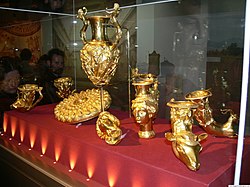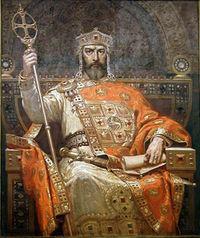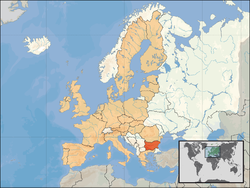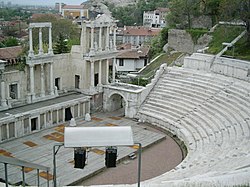Bulgaria (Bulgarian:
България),
officially the Republic of Bulgaria (Bulgarian:
Република България),
is a country on the
Balkan Peninsula, in
Eastern Europe. It borders the
Black Sea to the east,
Greece and
Turkey to the south,
Serbia and the
Republic of Macedonia to the west, and
Romania to the north, mostly along the
Danube. Bulgaria also shares a maritime border
with
Turkey,
Romania,
Ukraine,
Russia, and
Georgia. The capital of Bulgaria is
Sofia.
Bulgaria
is a country with an ancient history dating back to
prehistoric times, the
Thracian,
Greek and
Roman worlds of
antiquity and the powerful
Bulgarian Empire of the
Middle Ages founded in 681. Geographically and
climatically, Bulgaria is noted for its diversity,
with the landscape ranging from the
Alpine snow-capped peaks in
Rila,
Pirin and the
Balkan Mountains to the mild and sunny weather
of the Black Sea coast, from the typically
continental
Danubian Plain (ancient
Moesia) in the north to the strong
Mediterranean influence in the valleys of
Macedonia and the lowlands in the southernmost
parts of
Thrace.
Bulgaria
joined
NATO on
March 29,
2004 and the
European Union on
January 1,
2007. The country has been a member of the
United Nations since 1955, and is a founding
member of
OSCE. As a Consultative Party to the
Antarctic Treaty, Bulgaria takes part in the
governing of the territories situated south of 60░
south latitude.
| History Main article: History of Bulgaria |
The
Thracians were an ancient people who inhabited
what is now Bulgaria. They were divided in numerous
tribes until king
Teres united most of them in a single state
around 500 BC. This kingdom was called the
Odrysian state and reached its peak under the
kings
Sitalkes and
Cotys I (383-359 BC). In 341 BC it was destroyed
by the Macedonian state but rose from its ashes at
the end of the 4th century BC under
Seuthes III. In 188 BC the
Romans invaded
Thrace and the wars with them continued to
AD 45, when it became a
Roman Province.
The Thracians did not have writing
and now their legacy survives mainly in the numerous
treasures and tombs they left. It is believed that
the oldest golden treasure Ś the one of Varna, which
is 6,500 years old, is Thracian-made. One of the
most talented ancient commanders,
Spartacus, was a
Thracian born in the
Rhodope Mountains.
In the 632, the
Bulgars, led by Khan
Kubrat formed an independent state, often called
Great Bulgaria (also known as
Onoguria), between the lower course of the
Danube to the west, the
Black and the
Azov Seas to the south, the
Kuban river to the east, and the Donets river to
the north. The capital of the state was
Phanagoria, on the Azov.
The pressure from peoples further
east (such as the
Khazars) led to diminiton of
Great Bulgaria in the second half of the 7th
century. One Bulgar tribe migrated to the confluence
of the
Volga and
Kama Rivers and formed a new state called
Volga Bulgaria.
Another Bulgar tribe, led by Khan
Asparuh, moved westward, occupying todayÆs
southern
Bessarabia. After a successful war with
Byzantium in 680,
AsparuhÆs khanate conquered
Moesia and
Dobrudja and was recognised as an independent
state and formed the
First Bulgarian Empire in 681. In 717 the
Bulgarians helped relieve the
Arab siege of
Constantinople, killing some 40,000-60,000
soldiers. Their khan
Tervel was called by his contemporaries
The
Saviour of Europe. In 864 Bulgaria accepted the
Orthodox Faith and became a major European power in
the 9th and the 10th century, while fighting with
the
Byzantine Empire for the control of the
Balkans.. The greatest territorial extension was
reached under
Simeon I, the first
Tsar, covering most of the Balkans. Following a
decline in the middle of the 10th century, warned
out by the wars with
Croatia and frequent Serbian rebellions
sponsored by Byzantine gold, the Bulgarian state was
crushed by an assault of the
Rus' in 969. The Byzantines then began
campaigns to conquer Bulgaria. In 971 they seized
the capital
Preslav and captured emperor
Boris II. The resistance continued in the
western
Bulgarian lands for nearly half a century until
the state was completely destroyed by the
Byzantines led by
Basil II in 1018.







 See also:
See also:



